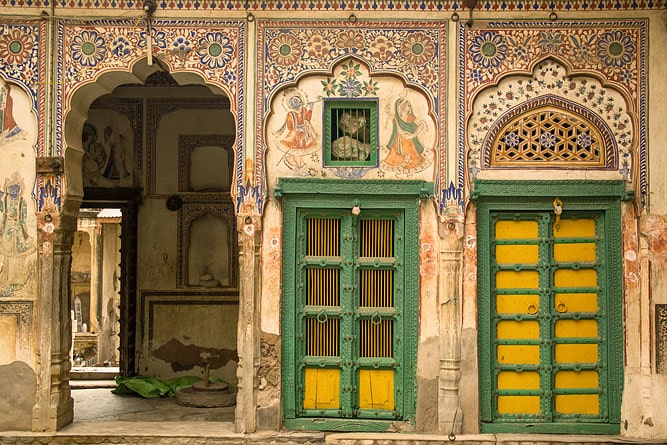Mandawa Havelis
must-see attraction
28°03'14.4"N 75°08'56.3"E
Historical region in the northeast of Rajasthan
must-see attraction
Visit duration: People typically spend 1 to 1.5 days here

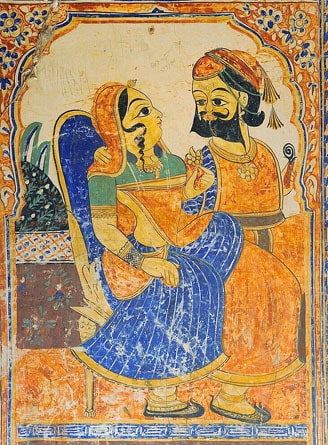
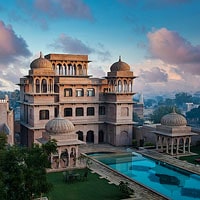
must-see attraction
28°03'14.4"N 75°08'56.3"E
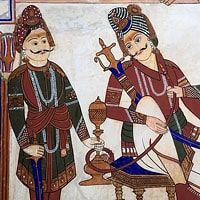
should-see attraction
27°51'18.1"N 75°16'32.8"E
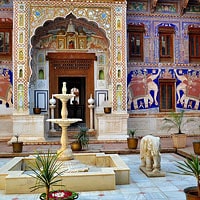
could-see attraction
28°00'02.7"N 74°57'46.9"E

could-see attraction
28°12'05.5"N 75°02'45.1"E
Shekhawati is an ancient region located in the northeast part of Rajasthan which was ruled by Shekhawat Rajputs. Back in the 17th to 19th centuries, Marwari vendors constructed grand edifices – homes (or havelis), temples, and step wells that enriched the architectural magnificence of the villages in the region.
Shekhawati region is most famous for its antique and ornamented havelis with Ragamala paintings complemented with mandalas, murals and arabesque designs. These extraordinary works of art are primarily located in the remote, arid countryside that is connected by a single-track road with barren fields on both sides.
The region got its name after its founder, Rao Shekha, a 15th-century Rajput Kachhwaha chieftain. From the 14th century onwards, the region of Shekhawati became an influential trading post on the caravan routes from Gujarati ports.
The bygone Shekhawati region was not confined to the present two districts. After the Gupta dynasty, the regions of Shekhawati were owned by the Chauhan Rajputs. However, the regions of Jhunjhunu and Fatehpur were controlled by the Muslim Kayamkhani Nawabs who were soon conquered by the Shekhawat Rajputs. They established their rule in 1445 and continued till the independence of India.
The Thakur of the Shekhawati remained faithful to the Rajput provinces of Jaipur and Amber, which in turn honoured them with the inborn titles of Tazimi Sardars. Although this undivided region was governed by a single family it was never united into a single principality, it remained as a separate, quarrelsome feudal domain.
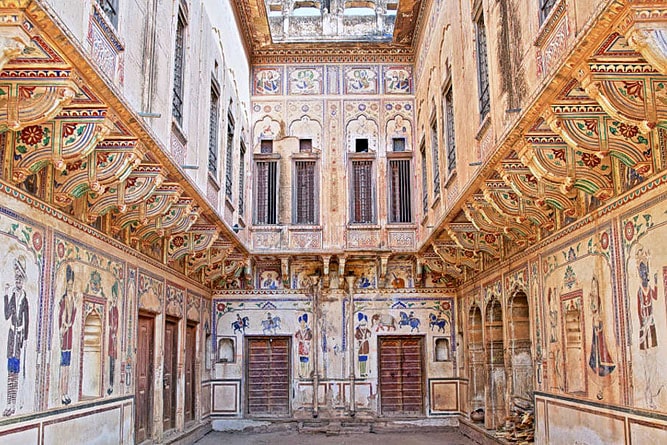
The artists who were liable for these acres of embellishment in Shekhawati were potters while many were from outside the region, mainly from Jaipur. They were given the responsibility to adorn the capital’s palaces.
The outcome was the blending of ideas and techniques among local artists and the workers from the capital. The early portraits were influenced by Mughal artworks of floral arabesques and geometric designs. The Rajput royal courts were another significant influence where illustrations from Hindu mythology dominated the theme with notable attention to lord Krishna.
The Europeans exposed an unexplored theme to the Shekhawati traders in Calcutta where walls were embellished with paintings of trains, planes, telephones, gramophones and bicycles. The artist in Shekhawati modified the themes into Krishna and Radha flying motorcars, while the British are consistently depicted as soldiers, with dogs or holding liquor.
The artwork on the Havelis of Shekhawati is so engaging because their artists combined traditional themes of mythology and religion with portraits of the family and contemporary themes where numerous of them yielded directly from the imagination of these artisans.
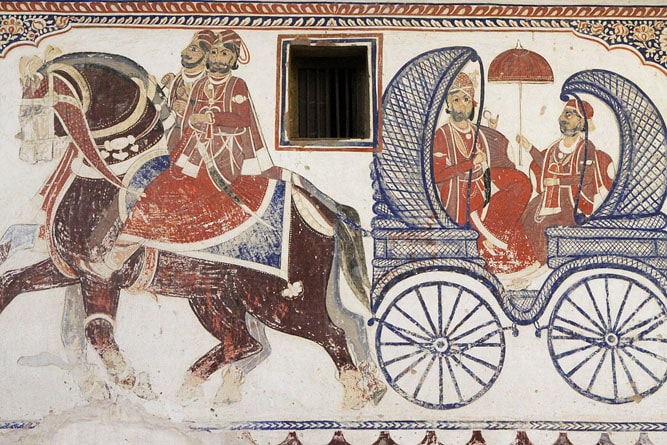
The hotels of Shekhawati offer various amenities that range from pocket-friendly budget hotels to luxurious stays. Some of the best abodes are mentioned as follows:
The Chobdar Haveli is located near the famous historical sites of Mandawa. It was built in 1900 and ornate with flower beds and a green lawn that reflects the classical Tibari style. The basic facilities include hot running water, laundry, a doctor on call, a tourist guide, an air-conditioned room. On special request puppet shows, magic shows, folk dances and music of classical Indian/Rajasthani performances can be arranged. It is a mid-budget hotel.
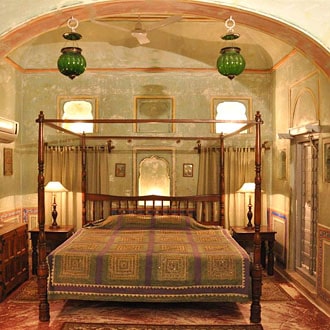
The hotel Radhika Haveli is located in Mandawa and is around 200 years old with ancient fresco paintings inside the haveli. The amenities of the hotel include a restaurant, a barbecue, horse riding and cycling, a children's playground, a terrace, free WiFi, a TV, a coffee machine, a kettle, air-conditioning room, a complimentary tour guide, hairdresser. The hotel is budget-friendly and is also pet-friendly and offers free breakfast.
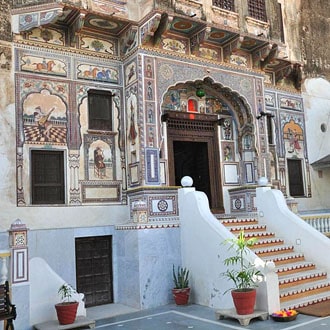
Vivaana Culture Hotel is situated in Mandawa, which is a thoroughly renovated 19th-century Shekhawati Haveli, featuring extravagantly decorated rooms and suites. Along with handmade large beds, and goose-down pillows they also provide facilities like a garden, courtyard, swimming pool, spa, guided Haveli tour, library, bar, fresco lounge, Rajasthani dining, cultural evening, live cooking, and terrace. It is a luxurious hotel offering elegance with comfort.
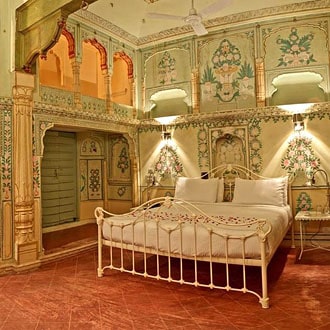
The Blusalz Vintage Harlalka Haveli, locally known as Harlalka Haveli, located in Mandawa, is almost 200 years old. This luxurious hotel offers an outdoor swimming pool with Jacuzzi, restaurants, laundry services, free high-speed internet connection, air-conditioning room, cable or satellite tv, room service and house-keeping, complimentary toiletries, lounging area, extra-long bed, the facility of shoe shine. The hotel gives you a simple luxurious village life experience. The hotel is an expensive option.
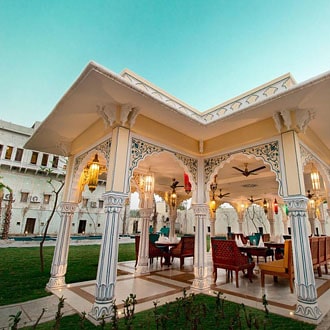
Hotel Shahi Palace is located in Mandawa. This hotel used to be a haveli that was built in ancient Rajasthani charm with modern amenities. Events like Rajasthani folk dance, music and puppet shows are arranged for the guests on request. The hotel also offers authentic Rajasthani cuisine along with continental menu. The haveli lets you enjoy the royal experience surrounded by serene ambience. Hotel Shahi Palace offers rooms at various prices from standard budget-friendly to luxurious suite at a mid-budget expense.
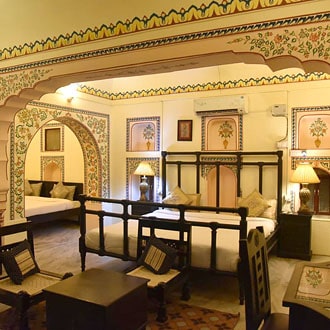
There are many places to eat at Shekhawati that comprises various cuisines that could be expensive or budget-friendly, offering you various options to choose from during the trip.
The Shekhawati Restaurant is located in Pramod Pareek, Mandawa. The restaurant stays open from noon till midnight. It is an Indian-Asian cuisine restaurant that serves traditional Rajasthani food like Dal Baati Churma Ker Sangrai Vegetable and Gatta Veg, Geera Aloo, Shahi Paneer and Lal Mutton and Chicken Special. The cost to eat at the restaurant is mid-budget which also offers vegetarian and vegan dishes.
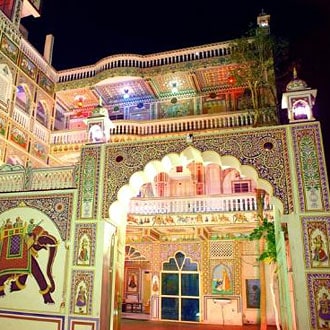
Mandawa Pavilion Roof Top Restaurant is located at Mukangarh Road, the restaurants opens at 9:00 am and closes at 10:00 pm. The restaurant offers Indian cuisine that serves Shekhawati local special food like dal-bati-churma, gatta curry, ker sangria, kadhi-Pakora, garlic chutney and Bajra roti. The extra amenities provided by the restaurant are outdoor seating, private dining, television, and free Wifi. It is a pocket-friendly restaurant that includes vegetarian, vegan, halal, kosher, and gluten-free menus.
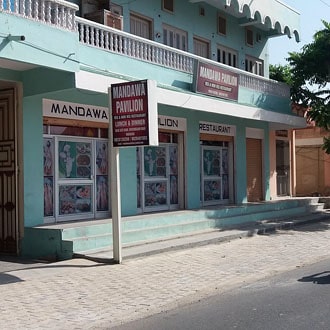
The Gwala Rooftop Restaurant is located near the main Bazar of Mandawa. They serve Rajasthani food in the traditional Shekhawati way. The cuisines also include Indian, Fast food, and Asian. The restaurant offers outdoor rooftop seating and also air-conditioned indoor seating. It has a bar and a cafe, wheelchair accessibility, television, free wifi and provides buffet service. The menu includes vegetarian and vegan and gluten-free options. It is a mid-budget restaurant.
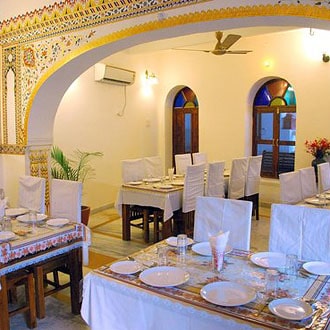
The restaurant is situated in Mandawa, it opens at 11:00 am and closes at 9:30 pm. Mandawa Kothi Restaurant serves a limited number of guests so a reservation is required to eat here. The cuisine of the restaurant is Asian, Indian, vegetarian and vegan-friendly. It consists of a pocket-friendly menu.
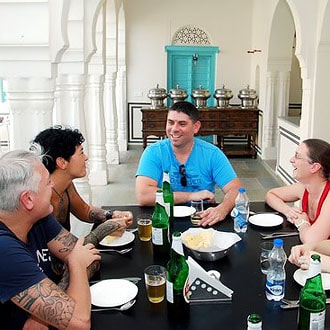
The restaurant is located in Castle Fort, Mandawa. It opens from 9:00 am to 10:30 pm. Mona Lisa Roof Top Restaurant is a multi-cuisine restaurant comprising Indian, Asian, Middle Eastern, Soups and Afghan dishes along with Shekhawati local special food like dal bati, churma, garlic chutney, ker sangria, kadhi pakora, gatta curry and bajra roti and also vegetarian and vegan options. A family-style restaurant that also features table service, outdoor and also private seating, television, puppet show, live music and folk dance. It is a mid-budget restaurant.
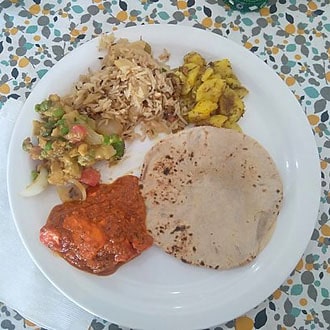
The drive from Delhi to Shekhawati (Mandawa) takes about 5 hours. From Jaipur and Bikaner, it is a shorter trip of about 3 to 3.5 hours by car.
See location on Google Maps
In the 18th and 19th centuries, Marwari traders lived far from home to earn money and sent their fortunes back to their families in Shekhawati to construct grand havelis as compensation for their long absences and compete with other merchants in their community.
Some havelis charge an entry fee while others are left in ruins and the rest of them do not allow the facility of the tour.
It would be better to travel in a group, as the concept of solo travelling by a woman is alienating for the people of the remote rural region.
